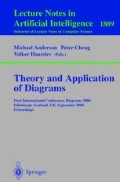Abstract
Diagrams have a long history as visual aids which assist in structuring and simplifying potentially complex reasoning tasks. Recent years have witnessed a rapid, ongoing popularisation of diagrammatic notations in the specification, modelling and programming of computing systems, leading to diagrammatic languages requiring increasingly complex semantic interpretations. A general theory of diagrammatic languages, following those of more typical text-based languages, requires as a minimum an account of diagram syntax, of semantics, and of interpretations: the relationships between syntax and semantics. A satisfactory theory of diagrams must also account for more cognitive aspects, notably the ways in which pragmatic features of diagrams contribute to their effectiveness for human users, and how individual cognitive differences affect human interpretation of diagrams.
Access this chapter
Tax calculation will be finalised at checkout
Purchases are for personal use only
References
M. Barr and C. Wells. Category Theory for Computing Science. Prentice-Hall, 1990.
J. Barwise and J Etchemendy. Heterogeneous logic. In J. Glasgow, N. H. Narayan, and B. Chandrasekaran, editors, Diagrammatic Reasoning: Cognitive and Computational Perspectives, pages 211–234. MIT Press, 1995.
Corin A. Gurr. On the isomorphism, or lack of it, of representations. In Kim Marriot and Bemd Meyer, editors, Visual Language Theory, chapter 10, pages 293–305. Springer, 1998.
David Harel. On visual formalisms. In Diagrammatic Reasoning: Cognitive and Computational Perspectives, pages 235–272. MIT Press, 1995.
Saunders MacLane. Categories for the Working Mathematician, volume 5 of Graduate Texts in Mathematics. Springer-Verlag, 1971.
D. Wang, J. Lee, and H. Zeevat. Reasoning with diagrammatic representations. In Diagrammatic Reasoning: Cognitive and Computational Perspectives, pages 211–234. MIT Press, 1995.
Author information
Authors and Affiliations
Editor information
Editors and Affiliations
Rights and permissions
Copyright information
© 2000 Springer-Verlag Berlin Heidelberg
About this paper
Cite this paper
Gurr, C., Tourlas, K. (2000). Formalising the Essence of Diagrammatic Syntax. In: Anderson, M., Cheng, P., Haarslev, V. (eds) Theory and Application of Diagrams. Diagrams 2000. Lecture Notes in Computer Science(), vol 1889. Springer, Berlin, Heidelberg. https://doi.org/10.1007/3-540-44590-0_42
Download citation
DOI: https://doi.org/10.1007/3-540-44590-0_42
Published:
Publisher Name: Springer, Berlin, Heidelberg
Print ISBN: 978-3-540-67915-8
Online ISBN: 978-3-540-44590-6
eBook Packages: Springer Book Archive

